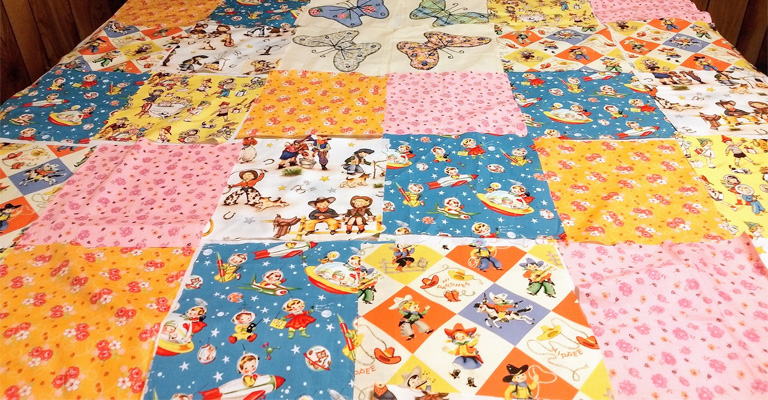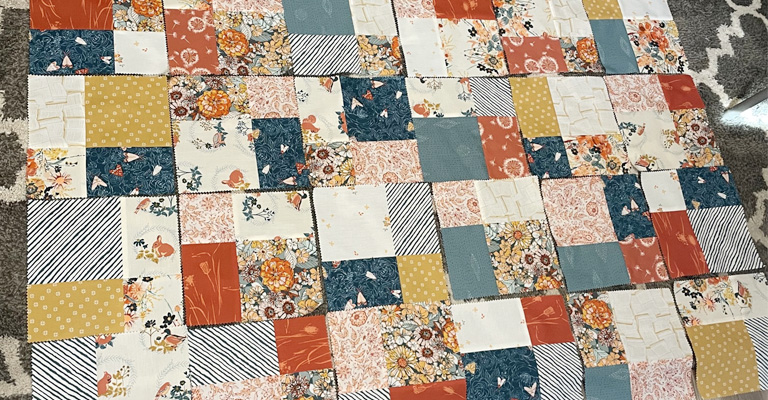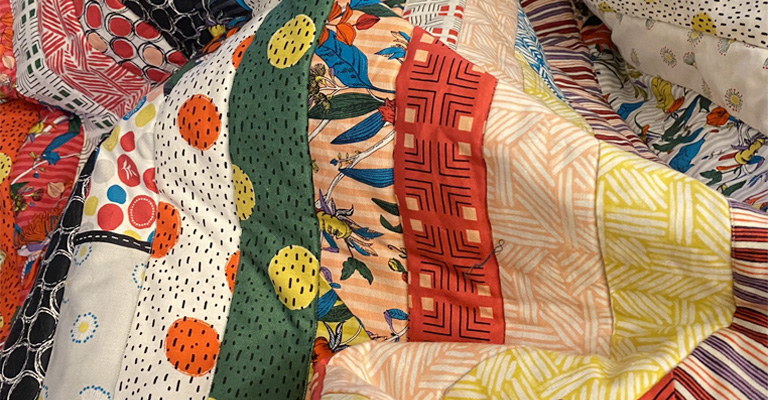Creating a quilt is a labor of love, blending artistry with craftsmanship to produce cozy, heirloom-quality textiles.
Yet, for those considering embarking on a quilting journey, a common question looms: how much does it cost to make a quilt? This inquiry opens a world of variables, where the size, materials, design complexity, and personal choices shape the answer.
From small lap quilts that offer warmth and comfort on chilly evenings to grand queen-sized creations adorned with intricate patterns, the cost spectrum is wide.
Unraveling this quilt-making cost puzzle requires a close look at factors such as fabric quality, quilting method, professional services, and additional supplies.
In this exploration, we navigate the terrain of quilt-making expenses, shedding light on how to balance creativity with budgetary considerations.

How Much Does It Cost to Make a Quilt?
The cost of making a quilt can vary widely depending on several factors, including the size of the quilt, the quality of materials used, the complexity of the design, and whether you do the quilting yourself or hire a professional.
Here are some general cost estimates for making a quilt:
Small Lap Quilt (Around 50 X 60 Inches)
For a basic lap quilt made with mid-range fabrics and a simple design, you might spend approximately $100 to $300. This estimate includes the cost of fabric, batting, thread, and other basic supplies.
Large Queen-sized Quilt (About 90 X 100 Inches)
If you’re making a larger quilt with higher-quality materials, intricate patterns, or professional quilting services, the cost can range from $500 to $2,000 or more.
Baby Quilt
Making a baby quilt typically costs less than a full-sized quilt. A basic baby quilt with budget materials might cost around $30 to $50, while a more elaborate one with high-quality materials could range from $75 to $150 or more.
Professional Quilting Services
If you choose to have your quilt professionally quilted, the cost can vary widely based on the size and complexity of the quilt. Professional long-arm quilters might charge anywhere from $0.01 to $0.10 per square inch or more for their services.
Diy Quilting
If you quilt the project yourself, you’ll mainly incur expenses for fabric, batting, thread, and your time. Costs can vary significantly based on the materials you choose and whether you already have quilting tools and a sewing machine.
Why Does It Cost So Much to Make a Quilt?

The seemingly high cost of making a quilt is a result of various factors that contribute to the overall expenses of this intricate and time-honored craft:
Quality Materials
Quilts require fabric, batting, and thread, all of which come in a wide range of qualities and prices. High-quality materials, while more expensive, often result in quilts that are visually appealing, durable, and comfortable.
Design Complexity
The complexity of the quilt design plays a significant role in its cost. Intricate patterns, appliqué work, embroidery, or the addition of embellishments demand more time, skill, and materials, driving up the overall expense.
Labor-intensive Craft
Quilting is a labor-intensive art form. Quilters spend countless hours cutting, piecing, and stitching together layers of fabric. More intricate designs or larger quilts require additional time and effort, which translates to higher costs.
Tools and Equipment
If you’re not already equipped with quilting tools and a sewing machine, the initial investment in these essentials can contribute to the overall expense.
Quality tools are often more expensive but can make the quilting process more efficient and enjoyable.
Professional Services
Some quilters opt to have their quilts professionally quilted, which adds to the cost. Professional quilters have the expertise and equipment to create finely detailed stitching patterns that enhance the quilt’s appearance and durability.
Additional Expenses
Quilting projects often involve additional costs, including backing fabric, binding, quilting classes or workshops, and any special tools or supplies required for a particular project.
Customization
Many quilters take pride in creating unique, personalized quilts, which may include custom-dyed or printed fabrics, adding to the overall cost.
How Much Does It Cost to Quilt a Blanket?

The cost of quilting a blanket varies depending on several factors. If you are referring to the cost of hiring a professional long-arm quilter to quilt your blanket, prices can range from $0.01 to $0.10 per square inch or more, depending on the complexity of the quilting design.
For a standard-sized queen blanket (approximately 90 x 100 inches), this could cost between $90 and $900 or even higher.
However, if you’re quilting the blanket yourself, you’d primarily incur costs for batting, thread, and your time, which can vary significantly based on materials and personal expenses.
How to Reduce the Cost of Making a Quilt?
Reducing the cost of making a quilt is possible with careful planning and smart choices. Here are practical ways to save money while creating beautiful quilts:
Set a Budget
The first step in cost-effective quilting is to establish a budget. Decide on a reasonable amount of money you’re willing to invest in your quilt project.
This budget will serve as your financial guide throughout the process, helping you make mindful spending decisions.
Shop Sales and Discounts
Keep an eagle eye out for sales, discounts, and clearance events at your local fabric and craft stores. Many retailers offer substantial discounts during holidays and seasonal promotions.
Subscribing to store newsletters or following them on social media can help you stay informed about these money-saving opportunities.
Use Your Stash
Before rushing to buy new fabric, take stock of your existing fabric stash. You might discover forgotten scraps or unused materials from past projects that can be incorporated into your quilt.
This not only saves money but also adds a personal touch to your creation.
Consider Pre-cuts
Pre-cut fabric bundles, such as charm packs, jelly rolls, or layer cakes, provide a cost-effective way to access a variety of coordinated fabrics without the need to purchase larger yardage.
They also reduce the time spent on cutting, making your quilting process more efficient.
Repurpose Fabrics
Think creatively by exploring the possibility of repurposing old clothing, linens, or textiles into quilt materials. This eco-friendly approach not only reduces costs but also gives your quilt a unique and sentimental dimension.
Buy Remnants and Scraps
Fabric stores often sell remnants and fabric scraps at discounted prices. These smaller pieces are perfect for smaller projects, adding texture to your quilts, or creating patchwork designs without breaking the bank.
Choose Cost-effective Batting
Select batting materials that align with your project’s requirements without exceeding your budget. Polyester batting is typically more affordable than natural fiber options like cotton or wool, providing good insulation for your quilt.
Diy Quilting
Consider quilting your projects yourself instead of paying for professional quilting services. Learning quilting techniques can be a rewarding and cost-effective way to personalize your quilts.
Join Quilting Communities
Engage with local or online quilting communities where you can exchange fabrics, patterns, and tips with fellow quilters. This collaborative approach can help you access new materials at lower costs.
Repurpose Quilt Backing
If you have leftover backing fabric from a previous quilt, repurpose it as the front or back of a new project. This not only reduces the need to purchase additional fabric but also adds continuity to your quilting journey.
Plan Efficiently
Maximize your fabric usage by planning your quilt layout and measurements meticulously. Precise measurements and efficient cutting can significantly reduce fabric waste, saving you money in the process.
Invest in Quality Tools
While quality quilting tools may have a higher initial cost, they often provide better results and longevity, potentially saving you money over time.
Invest in essential tools that will serve you well in multiple projects.
Take Quilting Classes
Enrolling in quilting classes or workshops can improve your skills and help you avoid costly mistakes. Learning new techniques can enhance your ability to make the most of your materials, ultimately saving you money on future projects.
Is Quilting an Expensive Hobby?
Quilting’s cost as a hobby varies widely. It can be affordable when using budget materials and basic tools, or it can become expensive with high-end fabrics and equipment.
The expense depends on personal choices like fabric selection, complexity of designs, and whether you use professional quilting services.
However, with prudent spending, utilizing scraps, and joining quilting communities for shared resources, quilting can be as affordable or as lavish as you desire, making it accessible to a wide range of budgets.
FAQs
Do I need to buy a quilting machine to make a quilt?
While a quilting machine can make the process more efficient, it’s not strictly necessary. Many quilters start with a regular sewing machine and eventually invest in a quilting machine if they continue quilting as a hobby.
Are there ongoing costs associated with quilting?
Yes, ongoing costs may include replacement rotary cutter blades, sewing machine maintenance, and the purchase of new quilting patterns or templates.
Can I make a quilt from recycled materials to reduce costs?
Yes, making a quilt from recycled materials, such as old clothing or linens, is an eco-friendly and cost-effective way to create unique and meaningful quilts.
What are some cost-effective alternatives to traditional batting?
If you’re looking to save on batting costs, consider alternatives like using flannel sheets, fleece blankets, or even layers of old blankets as batting.
Is quilting a cost-effective way to create personalized gifts?
Yes, quilting can be an affordable way to create heartfelt, personalized gifts for friends and family. You can tailor the materials and design to suit the recipient’s preferences and your budget.
To Recap
The cost of making a quilt is a multi-faceted puzzle, where creativity and budget considerations intertwine.
While the price tag may vary significantly based on quilt size, materials, and design complexity, it’s important to remember that quilting offers a canvas for artistic expression that can be adapted to different financial situations.
With careful planning, resourcefulness, and smart choices, quilting enthusiasts can embark on this rewarding journey without breaking the bank.
Whether you’re crafting a cherished family heirloom, a cozy lap quilt, or a thoughtful gift, the investment in time and materials is an investment in a piece of art that provides comfort, warmth, and a tangible expression of creativity for generations to come.
So, take up your quilting tools, embrace your vision, and sew the fabric of your dreams into reality.
Leave a Reply